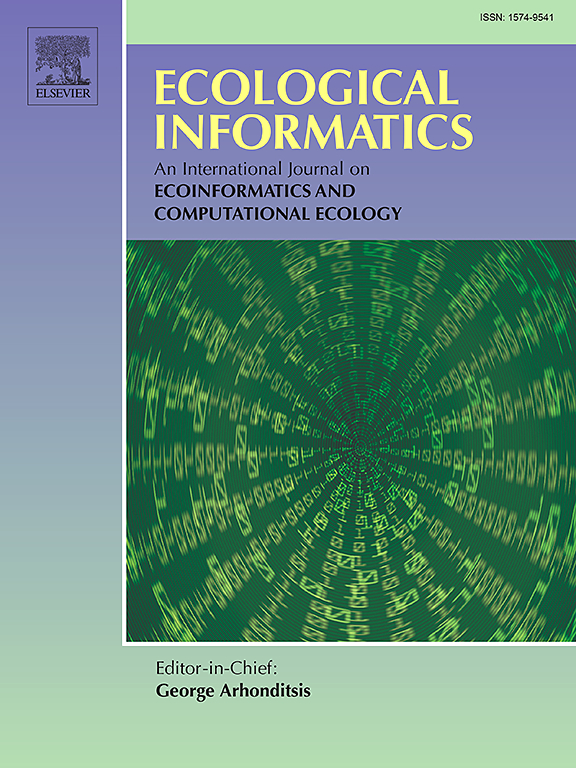Selecting of global phenological field observations for validating coarse AVHRR-derived forest phenology products based on spatial heterogeneity and temporal consistency
IF 7.3
2区 环境科学与生态学
Q1 ECOLOGY
引用次数: 0
Abstract
Global phenological field observations play a crucial role in validating remote sensing products and algorithms. However, due to the spatial mismatch and scale effect between the field observations and the pixels of remote sensing phenology products, a direct comparison often leads to scale errors and increased uncertainty. Therefore, evaluating the spatial representativeness of field observations for remote sensing product validation is essential. This study developed a novel “bottom-up” evaluation framework named MSPT (Main land cover type, Spatial heterogeneity, Point-area consistency and Temporal consistency), which comprehensively assesses the spatial representativeness of forest phenological field observations within the coarse spatial scale. Based on MSPT method, the capability of global forest phenological field observations to support coarse-scale remote sensing validation was evaluated. Compared with the general method, MSPT significantly improved validation performance. For the start of the growing season (SOS), the root mean square error (RMSE) decreased from 49.70 to 33.75 days, and the percent bias (PBIAS) changed from −0.14 to 0.03. For the end of the growing season (EOS), the RMSE was reduced from 83.42 to 42.53 days, and the PBIAS decreased from 0.15 to 0.08. These findings demonstrate that MSPT enhances the reliability of validation datasets and effectively reducing uncertainty in the evaluation of coarse AVHRR-derived forest phenology products. The framework offers new insights into resolving the scale mismatch between field observations and the pixels of remote sensing products.
基于空间异质性和时间一致性的avhrr粗森林物候产品的全球物候野外观测选择
全球物候野外观测在验证遥感产品和算法方面发挥着至关重要的作用。然而,由于野外观测数据与遥感物候产品像元之间存在空间失配和尺度效应,直接比较往往会导致尺度误差,增加不确定性。因此,评估遥感产品验证的野外观测的空间代表性是至关重要的。本文提出了一种新的“自下而上”的评价框架MSPT(主要土地覆被类型、空间异质性、点区一致性和时间一致性),在粗空间尺度下综合评价森林物候野外观测的空间代表性。基于MSPT方法,对全球森林物候野外观测支持大尺度遥感验证的能力进行了评价。与一般方法相比,MSPT显著提高了验证性能。生长期开始时,均方根误差(RMSE)从49.70天减小到33.75天,百分比偏差(PBIAS)从- 0.14减小到0.03。生长期结束时,RMSE由83.42 d降至42.53 d, PBIAS由0.15 d降至0.08 d。这些结果表明,MSPT提高了验证数据集的可靠性,并有效降低了avhrr衍生的粗糙森林物候产品评估中的不确定性。该框架为解决野外观测与遥感产品像元之间的尺度不匹配提供了新的见解。
本文章由计算机程序翻译,如有差异,请以英文原文为准。
求助全文
约1分钟内获得全文
求助全文
来源期刊

Ecological Informatics
环境科学-生态学
CiteScore
8.30
自引率
11.80%
发文量
346
审稿时长
46 days
期刊介绍:
The journal Ecological Informatics is devoted to the publication of high quality, peer-reviewed articles on all aspects of computational ecology, data science and biogeography. The scope of the journal takes into account the data-intensive nature of ecology, the growing capacity of information technology to access, harness and leverage complex data as well as the critical need for informing sustainable management in view of global environmental and climate change.
The nature of the journal is interdisciplinary at the crossover between ecology and informatics. It focuses on novel concepts and techniques for image- and genome-based monitoring and interpretation, sensor- and multimedia-based data acquisition, internet-based data archiving and sharing, data assimilation, modelling and prediction of ecological data.
 求助内容:
求助内容: 应助结果提醒方式:
应助结果提醒方式:


